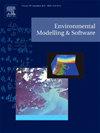A numerical model for simulation of bedload transport in unsteady trans-critical river flow
IF 4.6
2区 环境科学与生态学
Q1 COMPUTER SCIENCE, INTERDISCIPLINARY APPLICATIONS
引用次数: 0
Abstract
We present a numerical model for the simulation of unsteady trans-critical flow with bedload transport in rivers. The approach uses second-order well-balanced finite volume methods to solve the Saint-Venant–Exner equations with rectangular cross-section in 1 dimension. The equations are treated as a non-conservative hyperbolic system with distinct wave speeds, influenced by sediment transport processes. Two finite volume approximate Riemann solvers are implemented, based on an augmented Roe solver and an adapted HLL solver that both deal with the Saint-Venant–Exner equations as a coupled system. The three source terms of the model (bottom, friction and width) are discretized in a way that preserves of lake at rest equilibrium and positivity of the water depth. Model stability is ensured by a Courant–Friedrichs–Lewy (CFL) condition which depends on the wave speeds of the coupled system. Finally second-order schemes are proposed, based on a modified Heun time scheme and linear state reconstructions at cell interfaces and slope limiters. The paper highlights the challenges of computing the Jacobian matrix for various sediment transport models. We propose using different approximations of the wave speeds and present exact solid flux derivatives for many classical sediment transport laws. We also propose approximate solid flux derivatives which allow a simple generalization of the numerical model to any law, enabling real life industrial applications. The model’s performance was validated against analytical and experimental data, proving its sturdiness and precision. We also compare our approach to other numerical methods and to the Mascaret industrial code and its 1-dimensional sediment transport module Courlis.
非定常跨临界水流中河床输运的数值模拟模型
本文提出了一种具有河床输运的非定常跨临界流的数值模拟模型。该方法采用二阶良好平衡有限体积法求解一维矩形截面Saint-Venant-Exner方程。这些方程被视为具有不同波速的非保守双曲系统,受泥沙输运过程的影响。实现了两个有限体积近似黎曼解算器,基于增强型Roe解算器和改编的HLL解算器,两者都将Saint-Venant-Exner方程作为耦合系统处理。模型的三个源项(底部、摩擦力和宽度)以一种保持静止湖泊平衡和水深正性的方式离散化。模型的稳定性由柯朗-弗里德里希-路易(CFL)条件保证,该条件取决于耦合系统的波速。最后,基于改进的Heun时间格式和单元界面和斜率限制器处的线性状态重建,提出了二阶格式。本文强调了计算各种泥沙输运模型的雅可比矩阵所面临的挑战。我们建议使用不同的波速近似,并给出许多经典泥沙输运规律的精确固体通量导数。我们还提出了近似的固体通量导数,它允许将数值模型简单地推广到任何定律,从而使实际工业应用成为可能。通过分析和实验数据对模型的性能进行了验证,证明了模型的可靠性和准确性。我们还将我们的方法与其他数值方法以及Mascaret工业规范及其一维泥沙输送模块Courlis进行了比较。
本文章由计算机程序翻译,如有差异,请以英文原文为准。
求助全文
约1分钟内获得全文
求助全文
来源期刊

Environmental Modelling & Software
工程技术-工程:环境
CiteScore
9.30
自引率
8.20%
发文量
241
审稿时长
60 days
期刊介绍:
Environmental Modelling & Software publishes contributions, in the form of research articles, reviews and short communications, on recent advances in environmental modelling and/or software. The aim is to improve our capacity to represent, understand, predict or manage the behaviour of environmental systems at all practical scales, and to communicate those improvements to a wide scientific and professional audience.
 求助内容:
求助内容: 应助结果提醒方式:
应助结果提醒方式:


